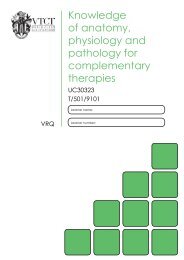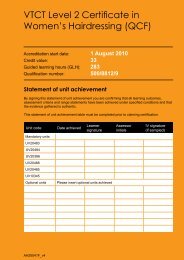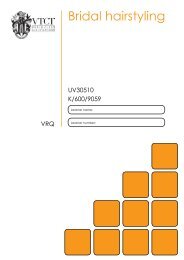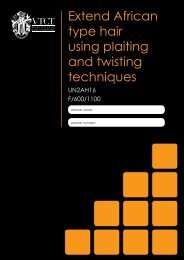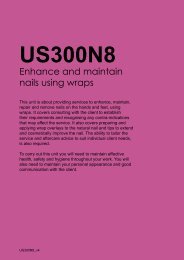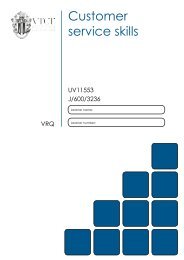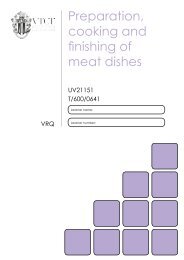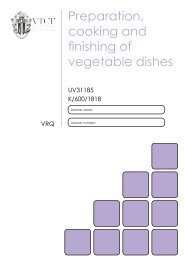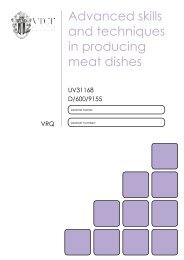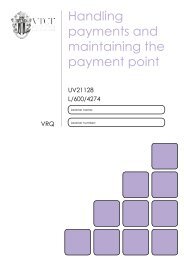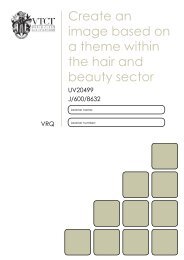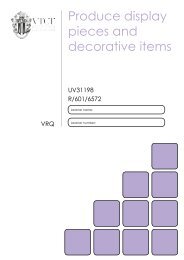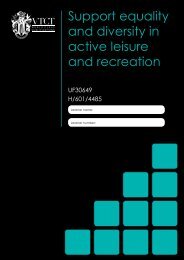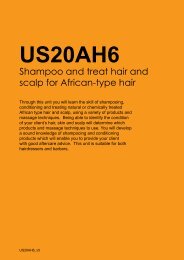Preparation, cooking and finishing of poultry dishes - VTCT
Preparation, cooking and finishing of poultry dishes - VTCT
Preparation, cooking and finishing of poultry dishes - VTCT
You also want an ePaper? Increase the reach of your titles
YUMPU automatically turns print PDFs into web optimized ePapers that Google loves.
VRQ<br />
<strong>Preparation</strong>,<br />
<strong>cooking</strong> <strong>and</strong><br />
<strong>finishing</strong> <strong>of</strong><br />
<strong>poultry</strong> <strong>dishes</strong><br />
UV21111<br />
J/600/0644<br />
Learner name:<br />
Learner number:
Statement <strong>of</strong> unit achievement<br />
By signing this statement <strong>of</strong> unit achievement you are confirming that all learning outcomes, assessment<br />
criteria <strong>and</strong> range statements have been achieved under specified conditions <strong>and</strong> that the evidence<br />
gathered is authentic.<br />
This statement <strong>of</strong> unit achievement table must be completed prior to claiming certification.<br />
Unit code Date achieved Learner signature<br />
Assessor tracking table<br />
<strong>VTCT</strong> is the specialist awarding body for the Hairdressing, Beauty Therapy, Complementary Therapy,<br />
Hospitality <strong>and</strong> Catering <strong>and</strong> Sport <strong>and</strong> Active Leisure sectors, with over 45 years <strong>of</strong> experience.<br />
<strong>VTCT</strong> is an awarding body regulated by national organisations including Ofqual, SQA, DfES <strong>and</strong> CCEA.<br />
<strong>VTCT</strong> is a registered charity investing in education <strong>and</strong> skills but also giving to good causes in the area<br />
<strong>of</strong> facial disfigurement.<br />
Assessor name Assessor signature<br />
Assessor<br />
initials<br />
Assessors<br />
initials<br />
IV signature<br />
(if sampled)<br />
All assessors using this Record <strong>of</strong> Assessment book must complete this table. This is required for<br />
verification purposes.<br />
Assessor number<br />
(optional)
UV21111<br />
<strong>Preparation</strong>, <strong>cooking</strong> <strong>and</strong><br />
<strong>finishing</strong> <strong>of</strong> <strong>poultry</strong> <strong>dishes</strong><br />
The aim <strong>of</strong> this unit is to develop your knowledge <strong>and</strong><br />
underst<strong>and</strong>ing <strong>of</strong> the preparation <strong>and</strong> <strong>cooking</strong> <strong>of</strong> <strong>poultry</strong>.<br />
You will learn the characteristics <strong>of</strong> different types <strong>of</strong><br />
<strong>poultry</strong>, their preparation methods, the equipment required<br />
<strong>and</strong> safe working methods.<br />
UV21111_v6
Level<br />
Credit value<br />
GLH<br />
2<br />
3<br />
26<br />
Observation(s)<br />
0<br />
External paper(s)<br />
0
<strong>Preparation</strong>, <strong>cooking</strong> <strong>and</strong><br />
<strong>finishing</strong> <strong>of</strong> <strong>poultry</strong> <strong>dishes</strong><br />
Learning outcomes Evidence requirements<br />
On completion <strong>of</strong> this unit you will:<br />
1. Know how to prepare <strong>poultry</strong> for basic<br />
<strong>dishes</strong><br />
2. Know how to cook <strong>poultry</strong> for basic <strong>dishes</strong><br />
3. Know how to finish <strong>poultry</strong> for basic <strong>dishes</strong><br />
1. Knowledge outcomes<br />
There must be evidence that you possess<br />
all the knowledge <strong>and</strong> underst<strong>and</strong>ing<br />
listed in the Knowledge section <strong>of</strong> this<br />
unit. In most cases this can be done<br />
by pr<strong>of</strong>essional discussion <strong>and</strong>/or oral<br />
questioning. Other methods, such as<br />
projects, assignments <strong>and</strong>/or reflective<br />
accounts may also be used.<br />
2. Tutor/Assessor guidance<br />
You will be guided by your tutor/assessor<br />
on how to achieve learning outcomes in this<br />
unit. All outcomes must be achieved.<br />
3. External paper<br />
There is no external paper requirement for<br />
this unit.<br />
UV21111<br />
3
4<br />
Developing knowledge<br />
Achieving knowledge outcomes<br />
You will be guided by your tutor <strong>and</strong> assessor<br />
on the evidence that needs to be produced.<br />
Your knowledge <strong>and</strong> underst<strong>and</strong>ing will be<br />
assessed using the assessment methods listed<br />
below*:<br />
• Projects<br />
• Observed work<br />
• Witness statements<br />
• Audio-visual media<br />
• Evidence <strong>of</strong> prior learning or attainment<br />
• Written questions<br />
• Oral questions<br />
• Assignments<br />
• Case studies<br />
• Pr<strong>of</strong>essional discussion<br />
Where applicable your assessor will integrate<br />
knowledge outcomes into practical observations<br />
through pr<strong>of</strong>essional discussion <strong>and</strong>/or oral<br />
questioning.<br />
When a criterion has been orally questioned<br />
<strong>and</strong> achieved, your assessor will record this<br />
evidence in written form or by other appropriate<br />
means. There is no need for you to produce<br />
additional evidence as this criterion has already<br />
been achieved.<br />
Some knowledge <strong>and</strong> underst<strong>and</strong>ing outcomes<br />
may require you to show that you know <strong>and</strong><br />
underst<strong>and</strong> how to do something. If you have<br />
practical evidence from your own work that<br />
meets knowledge criteria, then there is no<br />
requirement for you to be questioned again on<br />
the same topic.<br />
*This is not an exhaustive list.<br />
UV21111
Knowledge<br />
Learning outcome 1<br />
Know how to prepare <strong>poultry</strong> for basic <strong>dishes</strong><br />
You can: Portfolio reference<br />
a. Describe preparation methods for <strong>poultry</strong><br />
b. State the reasons for using different methods <strong>of</strong> <strong>poultry</strong> preparation<br />
c. Describe the characteristics <strong>of</strong> different types <strong>of</strong> <strong>poultry</strong><br />
d. State what should be done if there are problems with the quality <strong>of</strong><br />
<strong>poultry</strong><br />
e. Identify how to store prepared <strong>poultry</strong> which is ready for <strong>cooking</strong><br />
UV21111 5
6<br />
Learning outcome 2<br />
Know how to cook <strong>poultry</strong> for basic <strong>dishes</strong><br />
You can: Portfolio reference<br />
a. Identify the correct tools <strong>and</strong> equipment for different <strong>poultry</strong><br />
<strong>cooking</strong> methods<br />
b. Describe correct <strong>cooking</strong> methods for different types <strong>of</strong> <strong>poultry</strong><br />
c. State the correct temperatures for <strong>cooking</strong> <strong>poultry</strong><br />
d. State healthy eating considerations when <strong>cooking</strong> <strong>poultry</strong><br />
UV21111
Learning outcome 3<br />
Know how to finish <strong>poultry</strong> for basic <strong>dishes</strong><br />
You can: Portfolio reference<br />
a. Describe the correct <strong>finishing</strong> methods for <strong>poultry</strong> <strong>dishes</strong><br />
b. State the importance <strong>of</strong> correctly <strong>finishing</strong> <strong>dishes</strong> for service<br />
c. State how to check <strong>poultry</strong> <strong>dishes</strong> have met <strong>finishing</strong> requirements<br />
d. State the correct temperature for holding <strong>and</strong> serving <strong>poultry</strong><br />
<strong>dishes</strong><br />
UV21111 7
8<br />
Unit content<br />
This section provides guidance on the recommended knowledge <strong>and</strong> skills required to enable you<br />
to achieve each <strong>of</strong> the learning outcomes in this unit. Your tutor/assessor will ensure you have the<br />
opportunity to cover all <strong>of</strong> the unit content.<br />
Outcome 1: Know how to prepare <strong>poultry</strong> for basic <strong>dishes</strong><br />
<strong>Preparation</strong> methods for <strong>poultry</strong>:<br />
Trussing, checking the cavity, seasoning,<br />
marinating, weighing, cutting (portioning,<br />
dicing, boning), skinning, stuffing, coating.<br />
Reasons for using different methods:<br />
Recipe requirement, dish specification,<br />
<strong>cooking</strong> method, portion size, service style.<br />
Characteristics <strong>of</strong> different <strong>poultry</strong><br />
types: Size, weight, colour <strong>of</strong> flesh, texture,<br />
fat content.<br />
Different types <strong>of</strong> <strong>poultry</strong>: Chicken,<br />
capon, poussin, duck, turkey, goose,<br />
guinea fowl.<br />
Outcome 2: Know how to cook <strong>poultry</strong> for basic <strong>dishes</strong><br />
Tools <strong>and</strong> equipment: Ovens, deep-fat<br />
fryers, frying pans, sauté pans, sauce<br />
pans, grill, griddle, tongs, spiders, trays.<br />
Cooking methods for different types<br />
<strong>of</strong> <strong>poultry</strong>: Roast (whole <strong>poultry</strong>, turkey<br />
breast), shallow frying (chicken escalope),<br />
sautéing (chicken on the bone), stir frying<br />
(cut breast <strong>of</strong> chicken, cut turkey breast),<br />
pot roasting (whole <strong>poultry</strong>), poaching<br />
(chicken supremes), boiling (capon).<br />
Correct temperatures for <strong>cooking</strong><br />
<strong>poultry</strong>: Core temperature above 75°C,<br />
clear juices (except for duck/guinea fowl),<br />
compliance with food safety regulations.<br />
Healthy eating considerations: Selecting<br />
<strong>poultry</strong> which is naturally lower in fat/<br />
UV21111<br />
Problems with the quality <strong>of</strong> <strong>poultry</strong>:<br />
Reporting to supervisor, contacting<br />
suppliers, refusing delivery <strong>of</strong> <strong>and</strong> sending<br />
back <strong>of</strong> poor quality <strong>poultry</strong>, disposing <strong>of</strong><br />
<strong>poultry</strong> past use-by date.<br />
Storing prepared <strong>poultry</strong>: Refrigerated<br />
immediately at correct temperature<br />
between 0°C <strong>and</strong> 5°C, raw below cooked,<br />
correctly covered, strictly labelled <strong>and</strong><br />
dated, strict stock rotation.<br />
cholesterol/calories, choosing appropriate<br />
<strong>cooking</strong> methods (grilling, griddling,<br />
poaching), using unsaturated fats <strong>and</strong> oils,<br />
serving with fresh vegetables, serving with<br />
whole grain rice or pasta, using low fat<br />
ingredients in marinades (yoghurt, olive<br />
oil), remove skin.
Outcome 3: Know how to finish <strong>poultry</strong> for basic <strong>dishes</strong><br />
Finishing methods for <strong>poultry</strong><br />
<strong>dishes</strong>: Portioning, garnishing, sauces,<br />
accompaniments.<br />
Importance <strong>of</strong> correctly <strong>finishing</strong> <strong>dishes</strong><br />
for service: Dish specifications, customer<br />
expectation <strong>and</strong> satisfaction.<br />
Checking <strong>poultry</strong> <strong>dishes</strong> have<br />
met <strong>finishing</strong> requirements: Dish<br />
specification, photographs, advice from<br />
senior kitchen members, colour, texture,<br />
taste, seasoning, sauces.<br />
Correct temperature for holding <strong>and</strong><br />
serving <strong>poultry</strong> <strong>dishes</strong>: Comply with<br />
current food safety regulations, above<br />
63°C.<br />
UV21111 9
10<br />
UV21111<br />
Notes<br />
Use this area for notes <strong>and</strong> diagrams



